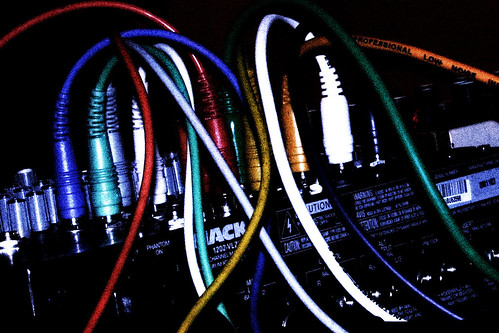What's a home music network?
July 01, 2011 in digital music by Dan Gravell

It used to be, that if you wanted a whole-home music system with centralised jukebox control and synchronisation between the music in different rooms, you'd have to fork out a whole wheelbarrow of money for a proprietary system. However, advances in technology, particularly in digital music, storage capacity and networking, now mean it's possible to accomplish home music networks for a much more reasonable cost.
Why have a home music network anyway?
Home music networks are distributed throughout the home. This means you can enjoy music in any room of the house. Importantly, the network has centralised control and storage. This means the music is stored in one place. If you are in bed and want to listen to some Debussy, you don't need to walk downstairs, get the the CD, walk back up, load the CD and press play. The music is stored centrally, so you use a controller to choose the Debussy recording you want and press play.
Having no requirement for physical CDs means you can also archive your physical media away, saving you valuable storage space.
Having different players in different rooms also means, given supporting hardware, you can synchronise playback between rooms. This is especially useful when hosting parties where guests may be in several rooms at once. Or, you might just want all downstairs rooms to be playing the same music as you do the housework!

Home music networks also go beyond merely playing recorded music. You can listen to Internet radio, podcasts and also connect to music streaming services. All of these additions combine digital music networks with the Internet and beyond what was possible with old proprietary services.
Closer to my own heart, the inherent flexibility of digital music means that is much easier to organise and categorise music so it's easier to find. It's much easier to find what you want to play, right now, even if you did't know what you wanted to play! For instance, feeling blue? Then just create a playlist based on your mood. Want to rock? Queue up those rock tunes!
Finally, this isn't so well known, but digital music also has the capability of being better than CD quality. If you have a real whizz-bang top-of-the-range hi-fi system to show off, this might matter to you. CDs are sampled at 44.1kHz, while music can now be purchased in digital form, either downloaded over the Internet or on DVD, at 96kHz and sometimes higher. Whether this makes much difference is down to your ears.
What's a home music network?
Broadly, a home music network is a group of components that connect, via wires or wirelessly, to control and playback your music.
Let's start with the most frequently used devices: network players and controllers. Network players are responsible for receiving music from the network and playing it, either via embedded speakers or separate speakers. Sometimes a player may also be connected into an amplifier. Controllers are used to choose what music is played and show the currently playing music. They are either embedded into the music player itself or are separate, like a traditional remote control or a more modern Internet tablet. Controllers build on digital music's flexibility by arranging your music by artist, genre, year and so on.
Normally you have one player per room. Each player connects to a central server which is responsible for storing the music and sending it to the players. The central server can be specifically created for music streaming or it can be a generic NAS server. The advantage of the former is that it's easier to combine other services as well as simple music streaming; podcasts and Internet radio for instance.

So much for the static side of your home music network. Most people want to leave the house at some point and they want to take their music with them.
Commonly you have personal MP3 players or mobile phones with music capabilities. These devices are synchronised with the home music network, so the same music appears on the mobile devices. Mobile devices are less capacious and sometimes music is transcoded to a lower quality so more music can be fit onto the device. Otherwise heuristics in the synchronisation software decide what music should be on each mobile device.
A new development in mobile music is the advent of the car computer or dodgily-named carputer. These are definitely at the hobbyist end of the market, but as they are essentially fully capable computers installed in a vehicle and capable of (amongst other things) displaying and playing music. Synchronisation of music is typically done by removable storage; either a USB key or external hard disk. More advanced are automatic synchronisation over wireless networks, so when your car is parked on your driveway it automatically synchronises your music.
Examples of home music networks
One inevitability of home music networks are that it's easier if you use all components from one manufacturer. It is possible to use different tools in your setup, but installation and upkeep tends to be easier with all in one solutions. It's only when your home music network's vendor doesn't provide a solution for a new project that you need to be a bit more do-it-yourself. Synchronisation with mobile devices often falls into this category.
The most common setup is probably the Apple iTunes and AirPlay combination. AirPlay is the networking technology that binds servers or 'senders', such as iTunes, to players or 'receivers', such as AppleTV. Apple now licence the technology so that different speaker systems can receive the music from iTunes. Coupled with iTunes synchronisation with iPhones and iPods, Apple have a very comprehensive home music product range.

Microsoft offer their Windows Media Center which, coupled with Media Center Extenders form your home music network. Windows Media Center is the server, responsible for storing and streaming music (it also records and streams video). The Extenders, the players in the network, connect to speakers to play the music.
There are a range of more specialist music network vendors. Sonos and Logitech sell reasonably priced home music networks. Sonos's allow streaming of music through a generic NAS, so you don't even need a normal computer or server turned on. Logitech's Squeezebox range require a central server, but this has bred a community of plugin writers to extend the abilities of the network. Both systems stop at the internal network; synchronisation with mobile players is something you'll have to sort out yourself.
Finally, and more expensively, there are a range of higher end music network vendors. These come from established audiophile manufacturers. Examples are Linn with their DS range, and Meridian's Sooloos. Like the Sonos and Squeezebox ranges, these are dedicated to networking around the home and don't really provide anything specific for mobile devices.
Scratching the surface!
That was just a gentle introduction to what home music networks are and their benefits. There's much more to discuss: vendor specific products and their capabilities, how you acquire music for your home music network and how you organise it (that one is particularly close to my heart!). I'm hoping to discuss these aspects in future home music network articles.
p.s. If you have a home music network you'd like to show off, let me know. The Music Library Management blog is always open to guest posts from readers with interesting digital music setups!
Thanks to Asiatic League, cauchisavona and jardenberg for the images above.

